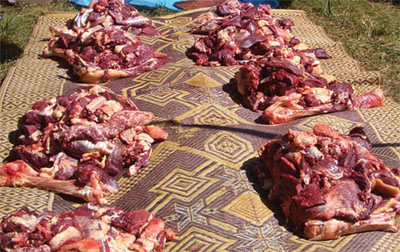Meat and its dangers
Meat is among the most highly nutritious foods. It is a good source of protein, fat and minerals. It is also a highly perishable product because cooked and especially raw meat (Figure 12.1) is a good substrate (underlayer) for the growth and multiplication of harmful microorganisms. As a result, several diseases may be transmitted to humans through the consumption of meat or meat products.

What are the most common perishable food items?
Common perishable foods are meat, milk, fish and vegetables.
Meat is the flesh of an animal used for human consumption. In this text ‘meat' refers mainly to the flesh of bovine animals i.e. cattle and oxen, generally known as beef, although of course there are other types such as sheep meat (mutton), goat meat, and pig meat (pork).
Diseases transferred to humans from animals are known as zoonotic diseases. One route of transmission of zoonotic diseases is by the consumption of infected meat.
The most common zoonotic diseases found in Ethiopia are:
Tapeworm infections are discussed in detail in Part 4 of the Communicable Diseases Module.
- bovine tuberculosis
- anthrax
- salmonellosis
- Taenia saginata, beef tapeworm infection, also known as kosso)
- Taenia solium, pork tapeworm infection
- hydatid disease
- diphyllobothriasis, fish tapeworm infection (Diphyllobothriasis is pronounced ‘diff-ill-oh-both-rya-sis').
- trichinosis
- toxoplasmosis.
Which of these diseases are caused by parasites?
All of them except the first three.